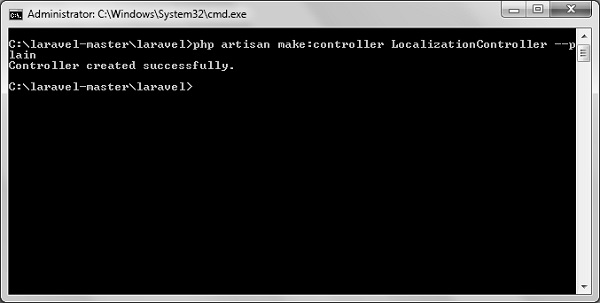Theoretical Paper
- Computer Organization
- Data Structure
- Digital Electronics
- Object Oriented Programming
- Discrete Mathematics
- Graph Theory
- Operating Systems
- Software Engineering
- Computer Graphics
- Database Management System
- Operation Research
- Computer Networking
- Image Processing
- Internet Technologies
- Micro Processor
- E-Commerce & ERP
- Dart Programming
- Flutter Tutorial
- Numerical Methods Tutorials
- Flutter Tutorials
- Kotlin Tutorial
- Laravel Tutorial
Practical Paper
Industrial Training
Laravel - Localization
Localization feature of Laravel supports different language to be used in application. You need to store all the strings of different language in a file and these files are stored at resources/views directory. You should create a separate directory for each supported language. All the language files should return an array of keyed strings as shown below.
< ?php return [ 'welcome' => 'Welcome to the application' ];
Example
Step 1 − Create 3 files for languages − English, French, and German. Save English file at resources/lang/en/lang.php
< ?php
return [
'msg' => 'Laravel Internationalization example.'
];
?>
Step 2 − Save French file at resources/lang/fr/lang.php.
< ?php
return [
'msg' => 'Exemple Laravel internationalisation.'
];
?>
Step 3 − Save German file at resources/lang/de/lang.php.
< ?php
return [
'msg' => 'Laravel Internationalisierung Beispiel.'
];
?>
Step 4 − Create a controller called LocalizationController by executing the following command.
php artisan make:controller LocalizationController --plain
Step 5 − After successful execution, you will receive the following output −

Step 6 − Copy the following code to file
app/Http/Controllers/LocalizationController.php
app/Http/Controllers/LocalizationController.php
< ?php
namespace App\Http\Controllers;
use Illuminate\Http\Request;
use App\Http\Requests;
use App\Http\Controllers\Controller;
class LocalizationController extends Controller {
public function index(Request $request,$locale) {
//set’s application’s locale
app()->setLocale($locale);
//Gets the translated message and displays it
echo trans('lang.msg');
}
}
Step 7 − Add a route for LocalizationController in app/Http/routes.php file. Notice that we are passing {locale} argument after localization/ which we will use to see output in different language.
app/Http/routes.php
Route::get('localization/{locale}','LocalizationController@index');
Step 8 − Now, let us visit the different URLs to see all different languages. Execute the below URL to see output in English language.
http://localhost:8000/localization/en
Step 9 − The output will appear as shown in the following image.

Step 10 − Execute the below URL to see output in French language.
http://localhost:8000/localization/fr
Step 11 − The output will appear as shown in the following image.

Step 12 − Execute the below URL to see output in German language
http://localhost:8000/localization/de
Step 13 − The output will appear as shown in the following image.


